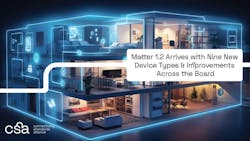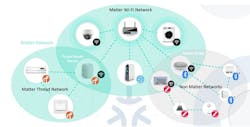This article is part of the TechXchange: Why Matter Matters.
Members can download this article in PDF format.
What you’ll learn:
- How the Matter protocol's unique architecture enables users to create complex, secure, and user-friendly IoT applications.
- How Matter's vendor-agnostic protocol simplifies the commissioning, operation, and management of smart-home appliances and other IoT devices.
- What it takes to start designing products that support the new Matter 1.2 protocol.
The Matter protocol is one of the more successful efforts to create a secure, product-agnostic standard for ensuring ease of use and operation of smart devices across many commonly used networking technologies. It was developed by the Connectivity Standards Alliance (CSA) to overcome the challenges that have prevented "smart" appliances and other devices for homes, buildings, and industrial applications from being more widely adopted.
In this article, we’ll explore some of the basic principles and technologies that the Matter protocol is based on as well as some of the important new capabilities stemming from the arrival of the latest Matter standard (V 1.2).1
Before we get down to the technical nitty-gritty, the following CSA video does a great job of explaining Matter's capabilities from the user's perspective, and how they help accelerate the adoption of smart-home devices and other IoT-based products.
Origins Matter
Matter's origins date back to 2019 when a "Project Connected Home over IP" (or "CHIP" for short) was founded by Amazon, Apple, Google, and the Zigbee Alliance to develop an open-source connectivity standard for smart-home and IoT devices. It would improve interoperability/compatibility between different manufacturers and networks. In addition to ease of use, CHIP's goals included several layers of baked-in security, including always allowing for local control as an option.
The group, which eventually became part of the CSA, introduced the Matter 1.0 standard. The intent was to facilitate set up and control smart-home devices from any compliant manufacturer with a single, simplified, consistent set of steps, and quickly connect those devices to one or more applications and platforms. Since then, the Matter group's membership has expanded to include many of the world's major semiconductor makers, appliance and consumer electronics manufacturers, design groups, and even network service providers.
Matter Protocol: Under the Hood
One of Matter's key architectural strengths is that it treats networks as shared resources. In other words, it doesn’t have any requirement for exclusive network ownership, or access. This enables users to build complex systems that overlay multiple Matter networks over the same set of constituent IP networks.
Another important contributor to its versatility is the use of addressing for its operational communication. The Matter standard contains mechanisms for resolving the node IDs and fabric IDs within the network it supports into various types of IPv6 addresses.
As a result, devices that support the Matter protocol can easily communicate with each other within and across network boundaries using existing technologies, including Bluetooth LE, Ethernet, Wi-Fi, and the Thread networking protocol. This makes it easy for Wi-Fi end devices, such as cameras, home appliances, and media players, as well as Wi-Fi 6 (plugged devices) products, to gain direct high-speed access to the internet.
For low-power, low-speed applications, such as battery-operated sensors, locks, and switches, Matter can work with end devices that use the Thread wireless protocol to connect to a local mesh network. In this case, an Open Thread Border Router (OTBR) provides access to the cloud. In addition, devices known as Matter Bridges can be used to translate traffic between an OTBR and existing wireless networks such as Zigbee, Z-Wave mesh, and Bluetooth mesh.
Although it leverages the IPv6 protocol, Matter is able to operate in the absence of a globally routable IPv6 infrastructure, enabling deployment of networks that are disconnected or firewalled from the global internet. This also allows it to be used in environments where the internet service provider either doesn’t support IPv6 on consumer premises or where the support proves otherwise limiting—for example, if the delegated prefix can’t accommodate all of the networks and devices on premises.2
Commissioning a device into a Matter network is done via the Bluetooth LE (BLE) wireless protocol using a Matter controller, which can be a mobile device or a home hub (smart speaker, smart display, etc.). Most products are designed to be set up using smartphone applications invoked by either numeric or QR codes. Once commissioning is complete, the device communicates with other devices across its assigned network and BLE is no longer used.
Bottom-Up Security
As one would expect, the Matter protocol uses end-to-end encryption as a frontline security measure against intrusion, spoofing, and other types of hacking. But Matter's ability to support multiple administrators unrelated by any common roots of trust (multi-admin) presented new vulnerabilities that required new solutions. One of the primary mechanisms used to secure this unique service is its ability to create and support multiple fabrics, i.e., a collection of Matter devices sharing a trusted root.
Matter's root trust mechanism is the root certificate authority (CA) that issues the node operational certificates (NOCs) underpinning node identities. Within the fabric, each node is uniquely identified by a stable node ID. A Matter device may be a member of multiple fabrics and thus have multiple associated node IDs.
Each node ID includes a fabric ID, which is a 64-bit number that uniquely identifies the fabric within the scope of a particular root CA. It also contains a 16-bit vendor identifier (allocated by the CSA), a 16-bit product type ID, and a 16-bit group identifier (group ID or GID) that identifies a set of nodes across an associated fabric of that device.2
Matter Evolution
When the Matter 1.0 specification was published in October 2022, it included support for lighting products (such as smart power outlets, electric lights, and switches), door locks, thermostats and heating, ventilation, and air-conditioning controllers, along with blinds and shades and home security sensors (e.g., door, window, and motion sensors). The spec also included support for home media products, such as televisions and streaming video players.
Feedback from initial adopters was used to create the Matter 1.1 specification (released in May 2023). It added bug fixes and enhancements to existing SDKs, APIs, and devices, but didn’t include support for any new product categories.
The Matter 1.2 standard, released in October 2023, now supports nine new device types:
- Washing machines
- Refrigerators
- Dishwashers
- Room air conditioners
- Robotic vacuum cleaners
- Air-quality sensors
- Air purifiers
- Smoke/carbon-dioxide alarms
- Fan control
"The recent arrival of the updated Matter 1.2 standard brings seamless provisioning and interoperability to many new classes of products and equipment as well as many important new capabilities,” said Rob Alexander, a Principal Product Manager at Silicon Labs.3
He continued, "Matter 1.2 adds new features that improve the user experience for commissioning to better describe the product or its elements. For example, a door lock could be described in a Matter controller's UI as having a chrome finish to help the user verify it is the same one they are interacting with, or a lamp with multiple bulbs can describe the location or position in a controller UI to make it clear which bulb is being bound to a smart switch."
While Alexander noted that Matter is currently being used mostly in smart-home products, the new capabilities and refinements available in Matter 1.2 should accelerate its acceptance in commercial, smart-city, industrial, and health applications. In their announcement, the CSA said that they expect Matter will receive two new updates in 2024 as part of a planned biannual release cadence that will steadily add more device types and expand Matter's ability to support these markets.
For further details, here are some good resources:
- A short but informative video from Texas Instruments provides another excellent overview of the Matter protocol, as well as some of the Matter-related products and tools they offer.
- Espressif Systems’ "Introduction to Matter" web tutorial provides a deeper introduction to the features of Matter and its benefits for developers and device makers. It also covers the details of the Matter ecosystem and Espressif's comprehensive Matter solutions. If you want to skip the overview and get to the technical details, begin viewing at 10:32 into the video. You can also download the slides at this link.
- Developers interested in learning more about Matter, and the new capabilities available in V1.2, can check out the Matter 1.2 specification and Matter 1.2 SDK Release.
Read more articles in the TechXchange: Why Matter Matters.
References
1. “Matter 1.2 Arrives with Nine New Device Types & Improvements Across the Board," Connectivity Standards Alliance, October 23, 2023.
2. “Matter Specification Version 1.0,” Connectivity Standards Alliance, Document #22-22349-001, Sept. 28, 2022.


